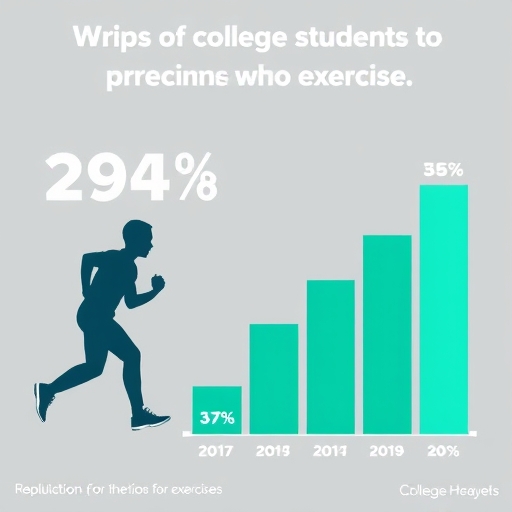Percentage of College Students Who Exercise
In today’s fast-paced world, maintaining a healthy lifestyle can be particularly challenging for college students. With academic pressures, social activities, and often limited time for personal care, exercise may take a back seat. This article explores the percentage of college students who exercise, the factors influencing their physical activity levels, the benefits of regular exercise, and practical tips to encourage a more active lifestyle.
Overview of College Student Exercise Trends
Current Statistics
Recent studies reveal varying statistics regarding the percentage of college students who engage in regular exercise. According to the American College Health Association, about 40% of college students reported meeting the physical activity guidelines recommended by the Centers for Disease Control and Prevention (CDC), which suggest at least 150 minutes of moderate exercise per week.
| Year | Percentage of Students Who Exercise Regularly |
|---|---|
| 2019 | 39% |
| 2020 | 41% |
| 2021 | 37% |
| 2022 | 40% |
Demographic Influences
The percentage of college students who exercise can vary significantly based on several demographic factors:
- Age: Younger students (18-20 years) tend to exercise more than older students (21+).
- Gender: Studies show that male students are more likely to engage in vigorous exercise compared to female students.
- Major: Students in health-related fields often exercise more than those in other disciplines.
- Living Situation: Students living on campus may have more access to facilities, influencing their exercise habits.
- Academic Pressure: Balancing coursework, exams, and assignments often leaves little time for exercise.
- Part-Time Jobs: Many students work part-time to support their education, reducing available time for physical activity.
- Peer Activity: Students are more likely to exercise if their friends are active.
- Campus Culture: Institutions that promote fitness through events and activities tend to see higher participation rates.
- Facilities: Access to gyms, sports fields, and fitness classes can significantly impact exercise habits.
- Cost: Membership fees for gyms or classes can deter students from participating in regular exercise.
- Stress and Anxiety: Mental health struggles can lead to a decrease in motivation to exercise.
- Depression: Students experiencing depression may find it challenging to maintain a regular exercise routine.
- Weight Management: Regular exercise helps in maintaining a healthy weight.
- Increased Strength and Endurance: Exercise builds muscle and improves cardiovascular health.
- Reduced Risk of Chronic Diseases: Regular physical activity lowers the risk of diseases such as diabetes, heart disease, and certain cancers.
- Stress Relief: Exercise is a proven method for reducing stress and anxiety.
- Improved Mood: Physical activity releases endorphins, which can improve overall mood and combat feelings of depression.
- Enhanced Cognitive Function: Regular exercise has been linked to improved concentration and academic performance.
- Opportunities for Social Interaction: Group exercises or sports can foster friendships and enhance social connections.
- Teamwork Skills: Participating in team sports can improve collaboration and communication skills.
- Workshops: Host workshops on the benefits of exercise and how to incorporate it into a busy schedule.
- Fitness Challenges: Create friendly competitions that encourage students to engage in physical activities.
- Campus Facilities: Ensure that gyms and recreational facilities are well-maintained and easily accessible.
- Affordability: Offer subsidized memberships or free fitness classes to students.
- Clubs and Organizations: Encourage the formation of fitness clubs where students can participate in group activities.
- Peer Mentorship: Create programs where more active students can mentor those looking to start exercising.
- Fitness Apps: Promote the use of fitness tracking apps that allow students to set goals and track their progress.
- Online Classes: Offer virtual fitness classes that students can access from their dorms.
- Walking or biking to class instead of driving.
- Joining a fitness class or sports team.
- Using short breaks between classes to do quick workouts or stretches.
- Scheduling regular workout times into their weekly planner.
Factors Influencing Exercise Among College Students
Understanding why college students may or may not exercise can help in creating effective strategies to promote physical activity. Here are some of the key factors:
Time Constraints
Social Influences
Accessibility
Mental Health
Benefits of Regular Exercise for College Students
Engaging in regular physical activity offers numerous benefits that can enhance both academic performance and overall well-being:
Physical Health Benefits
Mental Health Benefits
Social Benefits
Strategies to Encourage Exercise Among College Students
To increase the percentage of college students who exercise, institutions and students can implement various strategies:
Educational Campaigns
Improve Accessibility
Foster a Supportive Environment
Utilize Technology
Conclusion
The percentage of college students who exercise is a critical aspect of their overall health and well-being. While many students do engage in physical activity, there is still a significant portion that struggles to find the time and motivation to do so. By understanding the factors that influence exercise habits and implementing effective strategies, colleges and universities can help foster a culture of fitness and well-being among their students.
Frequently Asked Questions (FAQ)
What percentage of college students actually exercise?
Approximately 40% of college students meet the recommended guidelines for physical activity, which is at least 150 minutes of moderate exercise per week.
Why is exercise important for college students?
Exercise is crucial for maintaining physical health, improving mental well-being, and enhancing academic performance. It helps in stress relief, mood improvement, and social interaction.
What are some easy ways for students to incorporate exercise into their daily routines?
How can colleges encourage more students to exercise?
Colleges can promote exercise by improving access to facilities, offering fitness classes, organizing fitness challenges, and creating a supportive community for active lifestyles.
Are there specific sports that college students prefer?
While preferences can vary, popular activities among college students include running, cycling, basketball, soccer, and group fitness classes like yoga and Zumba.
By addressing the barriers to exercise and promoting the benefits of physical activity, colleges can help more students lead healthier, happier lives.





